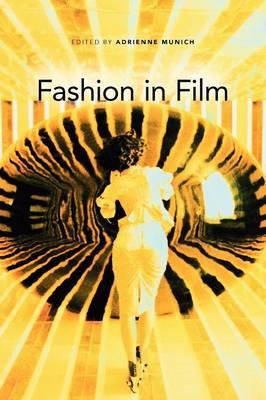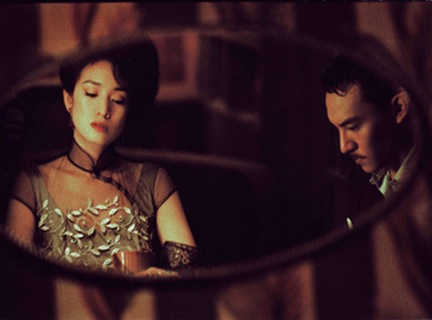| Adrienne Munich(ed.) Fashion in Film Indiana University Press, 2011 ISBN: 978-0-253-22299-2 US$27.95(pb) 376pp (Review copy supplied by Indiana University Press) |
 |
This is a joyful discovery: Fashion in Film, edited by Adrienne Munich is a box of delights. Indeed it is an indulgence to have so many excellent authors in one volume where the level of writing is extremely high. For film focussed fashion or fashion obsessed film scholars, there are a series of fourteen essays in which to luxuriate. An intriguing selection of topics marks an exciting diversity of film fashion writing, from vampires, Wong Kar-wai, Victorian dress, Sofia Coppola and Fassbinder, there is something to interest, inform and provoke.

Image from the Hand by Wong Kar-wai a segment from the omnibus Eros
In the first essay of the book “Costume Design, or what is fashion in film?” Drake Stutesman states that “fashion is now a public sensibility”, borne out by the vigour with which the authors approach their subjects. Stutesman himself leads the reader through the perspectives of clothing in design in film observing that,
Costume design plays on our deepest responses to clothes and all their aspects (shape, colour, texture), aspects which augment, indeed almost stand for, our perceptions of sex, authority, comfort, and stature. (20).
There are indeed very close comparisons to the role of the fashion designer. The starry-eyed view fashion and film as glamour, drama, and celebrity, but forget the business; they are both industries driven by profit. The designer and the director are only as good as their last collection, or film.
Within the book there are several outstanding essays such as Guliana Bruno’s “Surface, Fabric Weave: The Fashioned World of Wong Kar-wai” where she identifies the connected surface of fashion and film in the work of Wong Kar-wai. Lyrical in the descriptions of Kar-wai’s materiality, she describes his surfaces in elegant sensuous prose – it is a rare treat. Bruno follows the concept of film as tailoring,
A sartorial world unfolds in tessellated form here, stitched in patterns on the fibrous surface of intersecting screens…Film it can be said is a form of tailoring. (84)
An apt analogy as Kar-wai worked with William Chang Suk-ping who was editor, as well as production designer and costume designer. A minor criticism: her extrapolation of the Deleuze philosophy of the “fold” within Kar-wai’s work becomes over extended.
For fashion scholars “The Walkies: Early French Fashion Shows as Cinema of Attractions” by Caroline Evans is a revelation, charting the globalisation of French fashion via early film. Evans clearly describes the staging of haute couture on film, and the emerging tropes of salon and runway shows. The prospect of seeing a Paul Poiret show on film (now lost) is enticing.
Diana Diamond’s “Sofia Coppola’s Marie Antoinette: Costumes, Girl Power, and Feminism” which looks at a notorious fashion icon and a visually exquisite film, is a logical inclusion. The essay by Diamond makes for informative reading as the author explains in depth the relevance and style of the film. As undeniably beautiful as the costumes are, the acting and script, like the macaroons (the colour inspiration for the costumes) were colourful, insubstantial, and unsatisfying.
Perhaps those familiar with male body myths and national identity may know of the Italian Maciste films – for others they will be a discovery. Their refection of the shaping of the fascist identity in the early Twentieth Century is detailed in “Slave to Fashion: Masculinity, Suits and Maciste Films of Italian Silent Cinema” by Jacqueline Reich. This writing is a welcome addition to fashion theory in relation to men and menswear.
The essay on (Gilbert) Adrian “Wanting to wear seeing: Gilbert and MGM” by Jane M. Gaines provided a deep insight into the viewers’, consumers’, and the costume designers’ perspectives on his garments. In her analysis Gaines identifies “five theses of unwearability” in his complex work. The tension between Adrian’s wearable outfits, and his most spectacular outfits, sometimes used for only film promotion, mirrors that between ready-to-wear-collections, and the end of runway outfits of, for example, Vivienne Westwood and the late Alexander McQueen. Imagine Adrian’s sequinned cape for Sadie McKee (1934) on a runway or awards night red carpet!
Books on fashion and film have often discussed fashion and mean costume or product placement (the ubiquitous Armani). Fashion theory has been an alternative dimension for critics to postulate theories, as a type of terraforming. Over the last twenty years fashion has become a new domain for theorists from other disciplines to make unsolicited commentary, and pronouncements. It is exceedingly rare for reference to be made to fashion scholars or practitioners. Therefore it is heartening fashion scholars have been included and other authors reference fashion writers such as Breward and Wilson. The essay choices are eclectic, well written and insightful as both good fashion and film can be! The book makes a worthy inclusion for any fashion, or film, scholar’s library.
